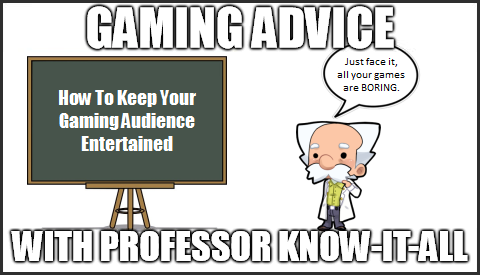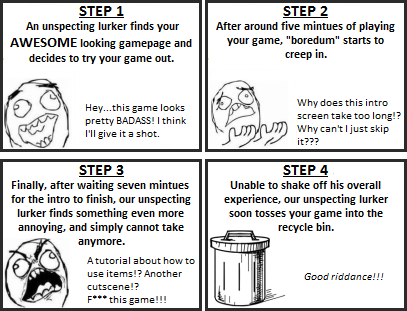GAMING ADVICE WITH PROFESSOR KNOW-IT-ALL: HOW TO KEEP YOUR GAMING AUDIENCE ENTERTAINED
Otherwise they’ll just go play something else that’s a lot more…“fun”
 Addit
Addit- 07/09/2013 11:27 PM
- 25423 views

Good day, ladies and gentlederps. The name is Professor Know-It-All. And I’m here today to teach you all about the secret art of game making and general game design. You can just call me “The Professor” for short, considering that’s what most people call me around here. For the next ten minutes, or however long it takes you to read all of this, I will be sharing my wisdom of many years of game making experience with you all. Although my speculative advice may come free and is considered well-informed by most, please take into the account that even I, the great and mighty professor can sometimes be faulty. So make sure that you have a clear head that is full of common sense and a willingness to go beyond the boundaries of knowledge as we take a look at today’s informal lesson.

Boredom.
Let’s face it, we’ve all sat through some pretty dull, dawdling moments in the course of our lives, whether it be some boring new reality show on T.V. that a friend is forcing us to watch or another bad George Lucas film – we’ve all been there, struggling to break free from the grotesqueness of our helpless situation. And in video games, it is no different. There are so many horror stories you’ve heard or seen that involves a game that may look good on the outside but it’s a whole different can of pinesap on the inside. You often hear about long loading times, frustrating controls, unskippable long cutscenes, boring tutorials, excessive level grinding, and, perhaps the most dire of them all, an unlikeable cast of characters with a lame ass, main villain with no real sense of purpose to his or her own schemes that it doesn't make a lick of sense of purpose to anyone, even you.
This, my friend, is just some of the many measures that drive people into utter insanity. And when the player can't simply take any much more of this hogwash, in a final desperate attempt of resistance, the game is suddenly then turned off. The game’s image is then removed from view from that person’s mind…forever.
My friends, this exact instance happens on this site EVERY. SINGLE. DAY! That’s right! While the overcrowded gleam of excitement may tickle your croissandwich, there are some rather brave souls out there going through the exact same motions that I just listed above. They download one of your games, think it’s pretty cool lookin’, give it a spin, find something that takes them out of the experience, and then – WAM! A bad review is pending.
Here’s a step-by-step comparison:

…And, thus, your game was never mentioned again.
But there is a way to save your precious lurkers and audience members from going through these same exact step-by-step motions? Oh, yes! By eliminating what stands as dire to those will generate more positive reviews and some more sexy fan-art for yourself (if you know what I mean).
My friends, I’m going to explain to you some of the types of steps to avoid having people go through the boredom phase. Although not everyone may find these distasteful; it’s usually just only a certain percentage of people that consider it acceptable more than anything else. But we want to eliminate such things as much as we can and gather a much wider audience to your game – both nerds and cool cats. Let’s break it down, shall we?
The introduction before officially having the player start the game should be as flashy and as brief as humanly possible. After all, you’re just giving your audience members a brief explanation about what is going on in your world and a brief summary of some of the characters that are involved in it. There is no need to go all out in your introduction phase, unless it plays a primary role in your overall story and contains rather important elements. For more experienced veterans, you should consider making your introduction skippable – especially for those who have already played your game once before. It also helps to break up the monotony by having the player thrown into the game rather immediately by participating in an event to help ease them into the experience. For a role playing game, this is pretty important. Most non-role playing games, like platformers, can usually just instantly send the player right to the start of the game with no explanation of what’s going on at all because most platformers don’t need that much of a story. Your introductions should be no more than 5 whole minutes. 5 whole minutes, tops. Count ‘em.
Similar to the introduction phase, you should also allow the player to have the ability to skip certain cutscenes to save them some time or save them from having to view the same scenes over-and-over again, especially if they died on a particular boss fight or during a tough challenge. Although some cutscenes may be important to the overall story and experience, some people just don’t really care. By adding in this feature, this can not only help save time but allow certain adrenaline junkies to do certain speedruns of your game and post it on someplace like YouTube to give your game even more intrigue. If you’re not going to add in the ability to have skippable cutscenes for some reason, at least have it so that the text speed can scroll down a lot faster than the usual normal speed. Same with the walking speed, if possible.
Tutorials “should” always be skippable and only be used to explain a system mechanic that is important towards the game’s overall completion. Teaching your audience how to play your game usually is best if you have them learn from your game rather hands on. Throw your player(s) into the lion’s den with a rather…certain circumstance and, after a while, they should get used to the game's mechanics rather quickly. A lot of earlier games used to do this back then and it still works rather well today. I mean, most of us are not that stupid to put two and two together. Keep the boring seminars down to a minimum.
Backtracking is a term for having to go back to previous locations or levels in your game after the player acquires something that allows him or her to achieve something that they couldn’t previously do before. Now, backtracking is a wonderful thing to include in your game IF IT IS DONE RIGHT! The best examples are those that have you backtrack in order to acquire more powerful items, spells, and equipment to make the game a whole lot easier to complete. It shouldn’t be used that often to have the player actually finish the game, as that should be more normal for the game’s overall progression.
Ah, the bane of most people’s resistance – especially in RPG’s: grinding. I’m pretty sure that you all have experienced this at least once in the course of your lives. Grinding is usually a mixed subject among those who play certain adventure / role playing games. Some people don’t mind spending some time fighting the same repetitive monsters over-and-over again using the same repetitive battle tactics, all in the name of growing stronger and actually having the ability to complete the game at a much easier level. For some, however, it’s quite daunting and can sometimes ruin the whole experience. So what’s a game maker to do to rectify this? How 'bout offer up a variance to your battle system to make them more interesting, like real-time combat or something of that nature. Or, how about reducing the number of times it takes to reach a new level, location, or even earn a particular new item? What about even finding a way to reduce battles at all? You see, RPG’s in general, are sometimes mostly focused towards the story. If your world, narrative, and characters are all your strongest attributes – why not focus more on them and less to do with all the other tedious stuff. Unless your game’s main focus IS the battles themselves, then you should try to keep grinding to a minimum. Besides, more time to enjoy the finer things in life – like going out for steak and lobster!
Variety is the spice of life, that’s what someone famous said. Instead of offering your player the same-old-same-old for most of your the game – try switching it up and offer them something new. Usually, mini-games and fetch quests can switch up the flow and give your game a little bit more personality. After all, you wouldn’t like doing the same thing over-and-over-and-over-and-over… *deep breath* and-over-and-over…
Leaving a player out to sea with no understanding of where to go or what to do next will probably result in them giving your game a complete shutdown. You see, sometimes a strategy guide isn’t available for your audience, not to mention you have other things to do with your busy time, like flossing your teeth and looking at your self in the mirror, and you certainly don’t want to have to hold his or her hand through the whole way through, right? Sometimes a good idea is to have a gentle reminder of what the player needs to do next so things aren’t so cryptic for them to understand what to do next. Sure, you don’t want to completely do it yourself and have them just breeze through everything and just sit there, but a little gentle push never hurt anyone.
In the end, we play games to be entertained – not tortured. Whenever you try to play your own game and you think others might enjoy it as well - ask yourself this question: “is this game as much fun for me as it will for them?” Because in the end, that’s what your audience wants; an enjoyable experience that is well worth their time.
Class, whatever you wish to place in your own games is up to you. And by no means should you take my advice to total heart. But remember that sometimes playing a game is like driving a car. You’re doing several different things while you drive that switches up the pace and keeps it from not being too repetitive, like checking your mirrors, looking to see how much mileage you piled up, chatting to your friend in the backseat, counting different colored corvettes that drive by – tons of things. Driving may be the main part of the experience, but you’re constantly doing many other things too to keep it still enjoyable. Keep that in mind as you design and build your games. Remember, nobody ever remembers the boring, boggled down parts of a game; they just remember the good parts, the good times. Even if it shaves off just a few hours of your total game's titme, it’s better to keep it short than keep it long.
Class dismissed.















